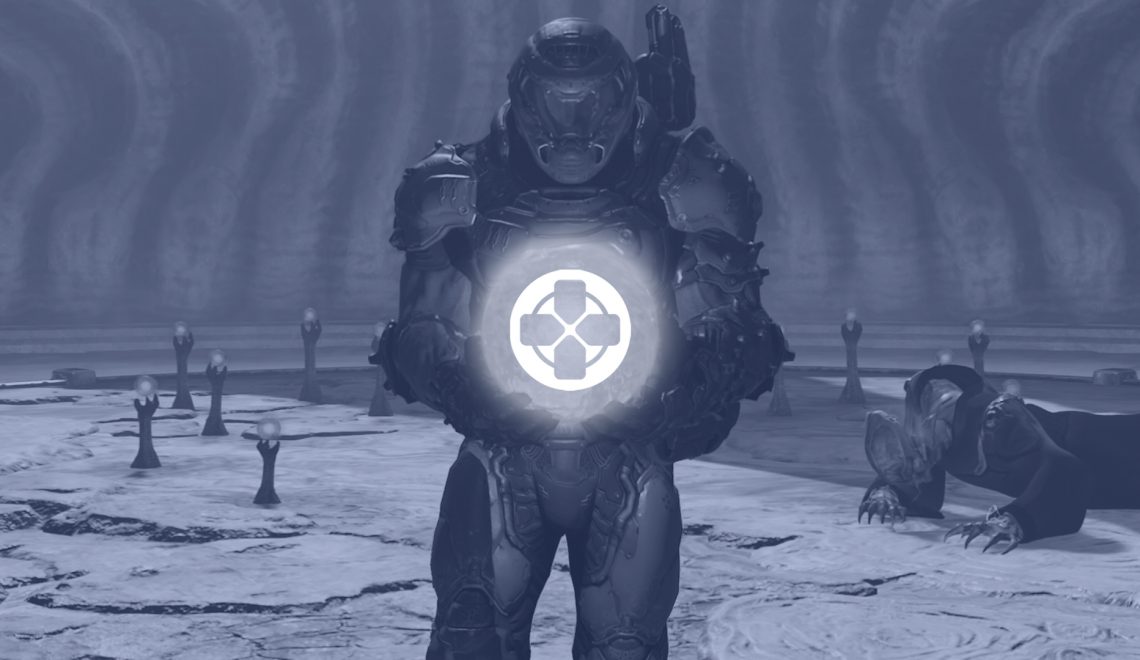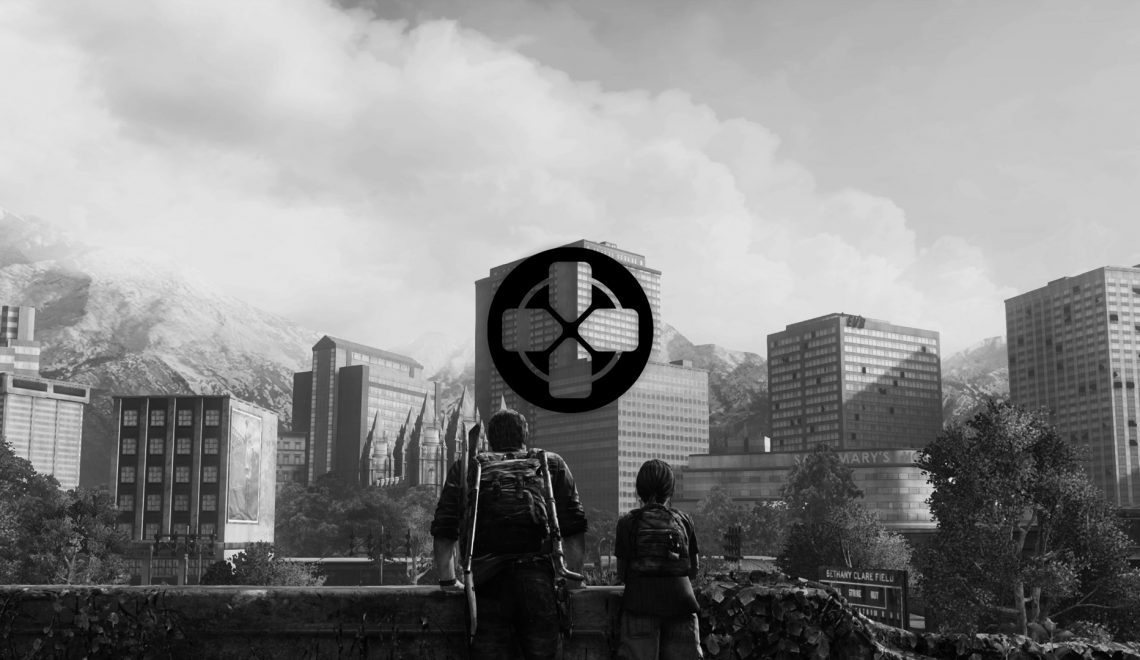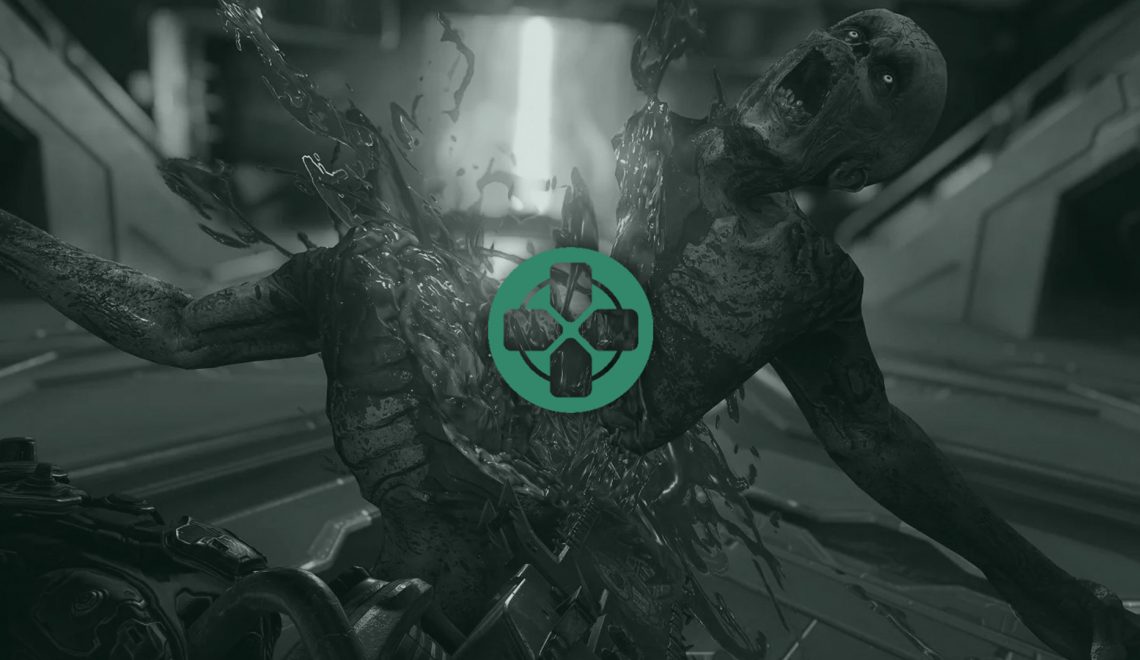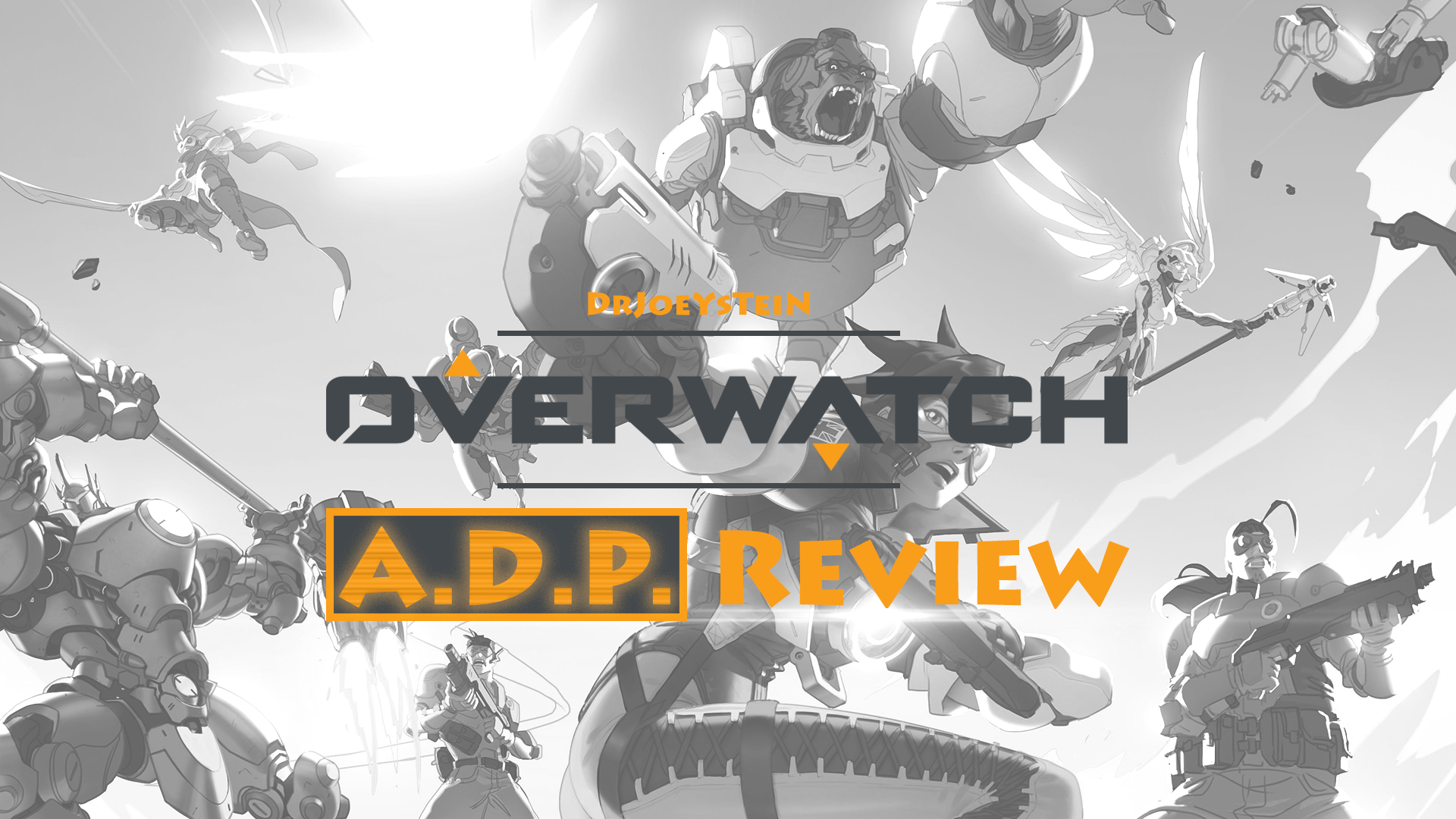
I’m not prone to become engrossed in video games these days. Sure, I’ll fawn over the likes of Metal Gear Solid V: The Phantom Pain and DOOM while I’m playing them because they’ve earned my attention, but I don’t continue to invest in them or actively proclaim their greatness once I’ve had my fill. Regardless, who doesn’t wish to spread the good news of games like these that you enjoy once you’ve discovered them? We want to have others share in the same joys we feel, but the degrees to which we’re motivated to evangelize about a particularly special something vastly vary, which depend on how much and how long a given thing is important to us and preoccupies our minds. For example, I’d enthusiastically tell you that Assassin’s Creed IV: Black Flag is still one of the best titles in the series since Brotherhood. I’d rave about how fun navigating the Caribbean islands is by land or sea and how the narrative takes intriguing twists in how it handles the future and historical storylines, serving as an excellent entry point for new fans while providing fan service for longtime players. It’s a great game by all means for these reasons and more, but once I had gone through the campaign, I felt no desire to linger in it. I moved on to other titles and filed this one away because I wasn’t interested in acquiring every collectable and the multiplayer. It was fun while it lasted.
Now, if we’re talking about Call of Duty: Black Ops or Transformers: War for Cybertron, those were games that weren’t only great for a brief stint. They continually held my attention months after I had purchased them. I went through the main experiences they offered, but went on to play their campaigns twice on harder difficulties. I spent inordinate amounts of time engrossed by their multiplayer modes and earned their Platinum Trophies, too. Outside of actually playing the games, I ardently followed any news associated with them, especially if it involved upcoming DLC. My point writing this? There’s a special difference between games that grab your attention for a short time versus a prolonged time, and I’m not talking about games designed to be short. I’m referring to ones that can be hypothetically enjoyed for hours beyond the main show with extra content and multiplayer-centered modes. They try to entice you with more if you dabble in the additional stuff, but many of these games just don’t motivate you enough to put in the extra effort. It’s not that they’re bad. It’s just that they’ve outstayed their welcome. I always shift to the next game as soon as reasonably possible, which helps me realize what little time I have to be devoting to single games anyway. It’s clockwork.
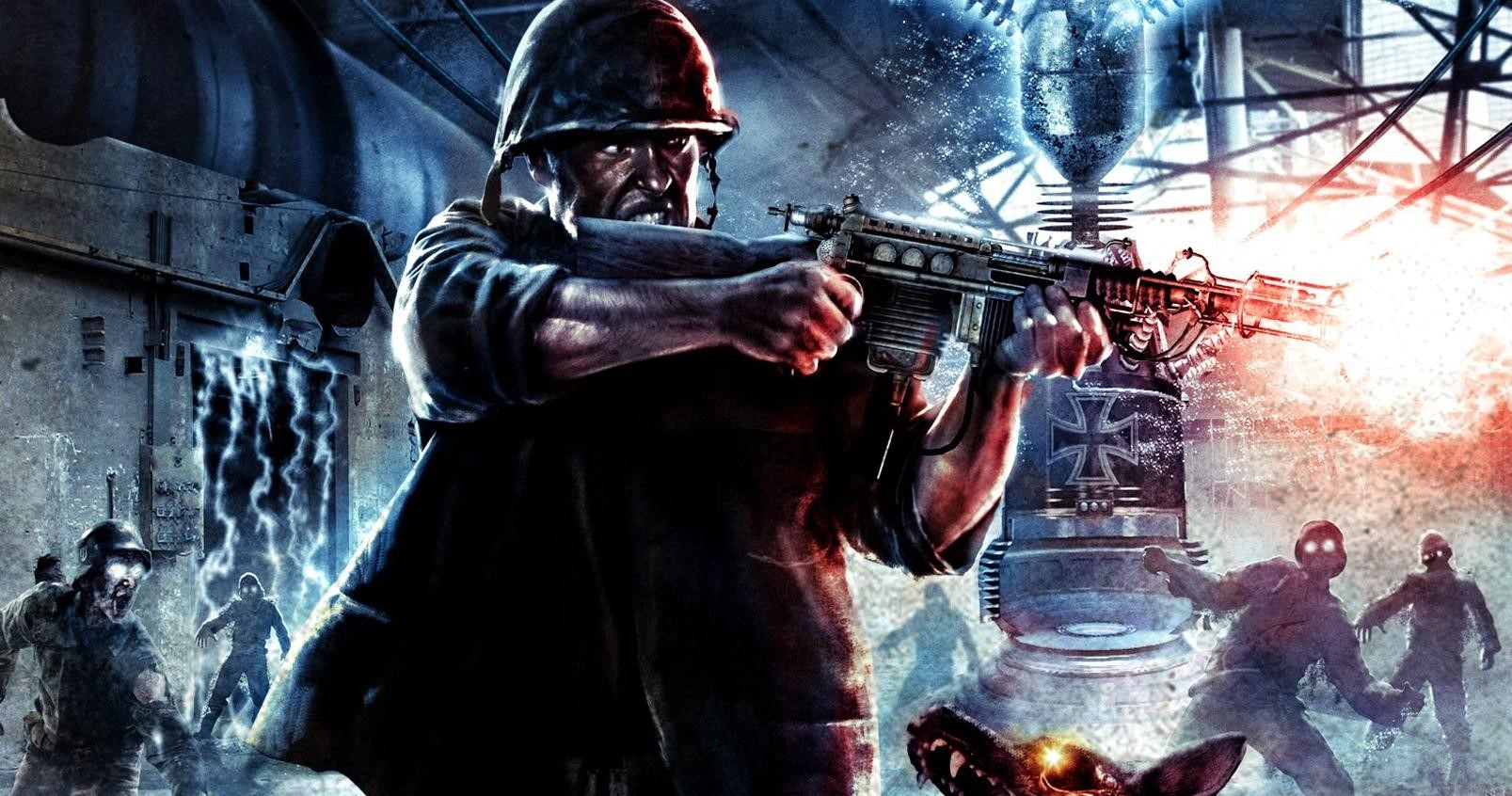
Call of Duty was, ironically, one of the first games that truly taught me the excitement and importance of teamwork with its Nazi Zombies mode. It drew me in for hours upon hours.
While you wouldn’t currently see me playing those titles I mentioned, that kind of burning, lasting passion is something I haven’t felt in years for many other games. With so many to play, a game has to be exceptionally good to bring my backlog progression to a standstill. If I devote myself to one game not for review purposes or simply because it’s long, but because I simply can’t get enough of it beyond the core experience, I know it must speak to me on an intimate level if it actively pulls me away from my responsibilities and other entertainment sources.
Overwatch is that kind of game. I can’t stop playing it. I can’t stop gushing over it. I love Overwatch.
I remember the days of my teenage youth spent year-round playing at least 1-2 hours of Call of Duty every day until the next one was released. Eventually, this habitual cycle I had with the franchise was broken and with most games I played because I was able to better control my impulses and desire to play games more than I should. Blizzard’s latest has rekindled this old flame of mine. It’s a multiplayer first-person shooter that I’m compelled to delve into every day despite its seemingly repetitious content. What could make it so good that my interest in it has yet to wane in the slightest? Let me tell you how that’s possible with a game that never fails to suck you back in with its infectious charm and glorious gameplay.
This World Is Worth Fighting For
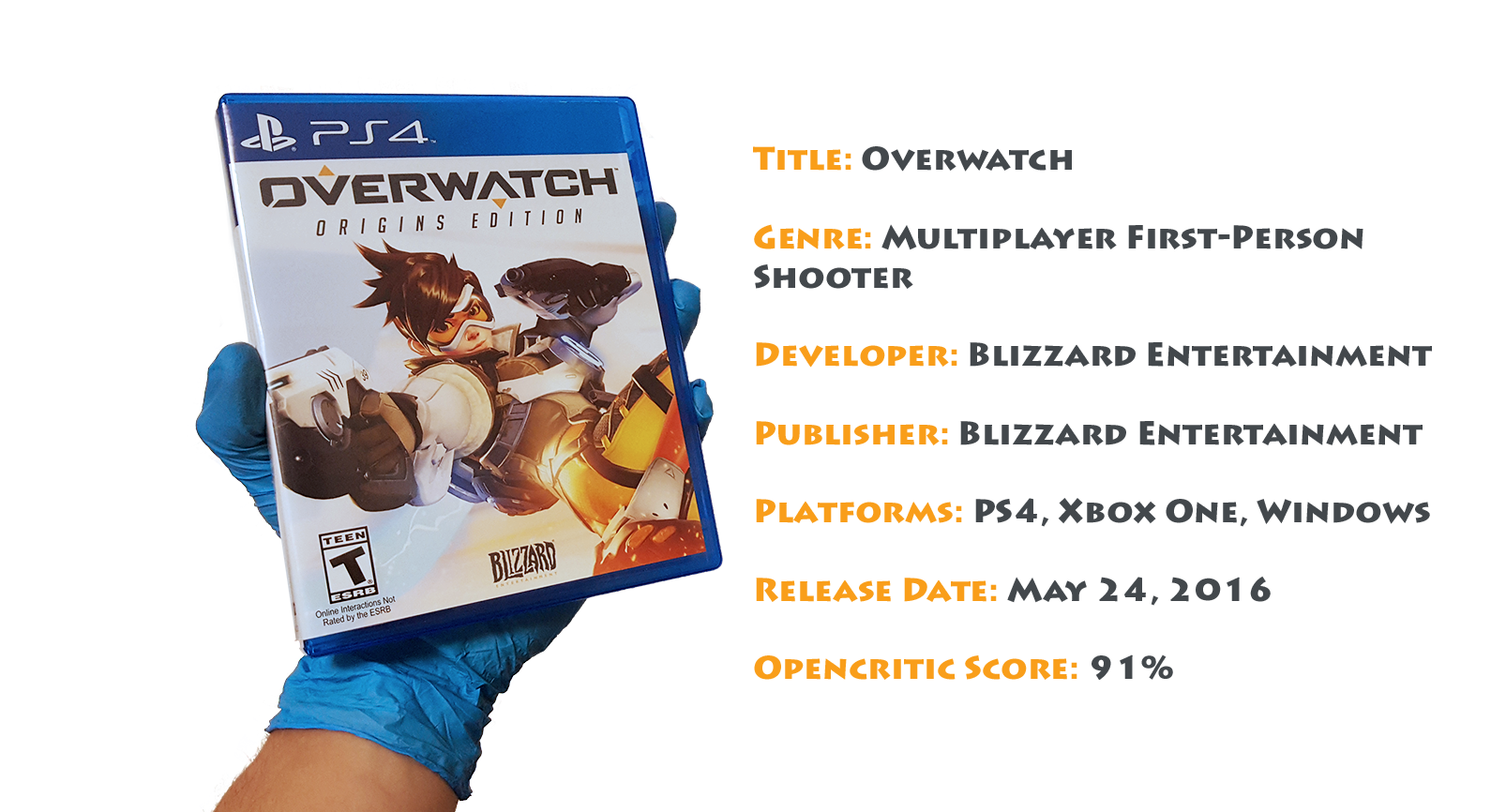
YouTube Version of the Review at the End!
Story
Overwatch poses a unique problem because it doesn’t have a dedicated campaign story. Any kind of plot or character details that form the tapestry of Overwatch’s lore can be ignored without compromising the primary enjoyment the game brings, much like with the Souls series, Tom Clancy’s The Division, or – arguably, I might add – Destiny. However, while you’re slowly familiarizing yourself with all of the characters and world they inhabit while playing, willingly not paying attention to the backstories associated with them would prove to be an immense challenge since they’re so interesting. Characters will briefly banter with cryptic lines and telling words that reveal their relationships with one another, the history behind maps, their individual motivations and quirks, and more. So when it comes to these characters, where do they come from? How do they know each other? What’s the state of their world? It all stems from a group of heroes under the titular title of Overwatch.
In the not-so-distant future, humanity is having a golden age of prosperity and innovation, particularly in the field of robotics with Omnics. These robots with advanced AI capabilities stunned the world with what they could do, prompting the construction of Omnium factories in key locations around the globe, which turned around its economy for the better in countless ways. As we all know though, AI always goes wrong at some point. The Omniums began producing murderous Omnics en masse, quickly forming armies that posed a serious threat to our race’s survival. While no one knows why this occurred and how, the United Nations created a small task force of heroes called Overwatch, which was created to rescue humanity from this Omnic Crisis. Heroes such as Jack Morrison, Gabriel Reyes, Reinhardt Wilhelm, and Angela Ziegler are a few of the original, leading members, who fought back the Omnics and saved the world. Inspiring old and new generations with its deeds and continued existence to preserve order and safety long after the Omnic Crisis, Overwatch was unfortunately accused of misconduct, corruption, and other unethical practices as time marched on. Turmoil brewing in its ranks didn’t help the situation either, which resulted in a devastating attack on Overwatch’s headquarters and its forced disbandment with the United Nations’ PETRAS Act. Veterans of the glory days and new, promising rookies could no longer work together, opting to go their own ways. However, with a Second Omnic Crisis on the rise, a shocking campaign of civil rights for neutral, sentient Omnics, and criminal activity increasing day after day, Overwatch is recalled several years later. Legal ramifications be damned. The world needs its heroes more than ever.
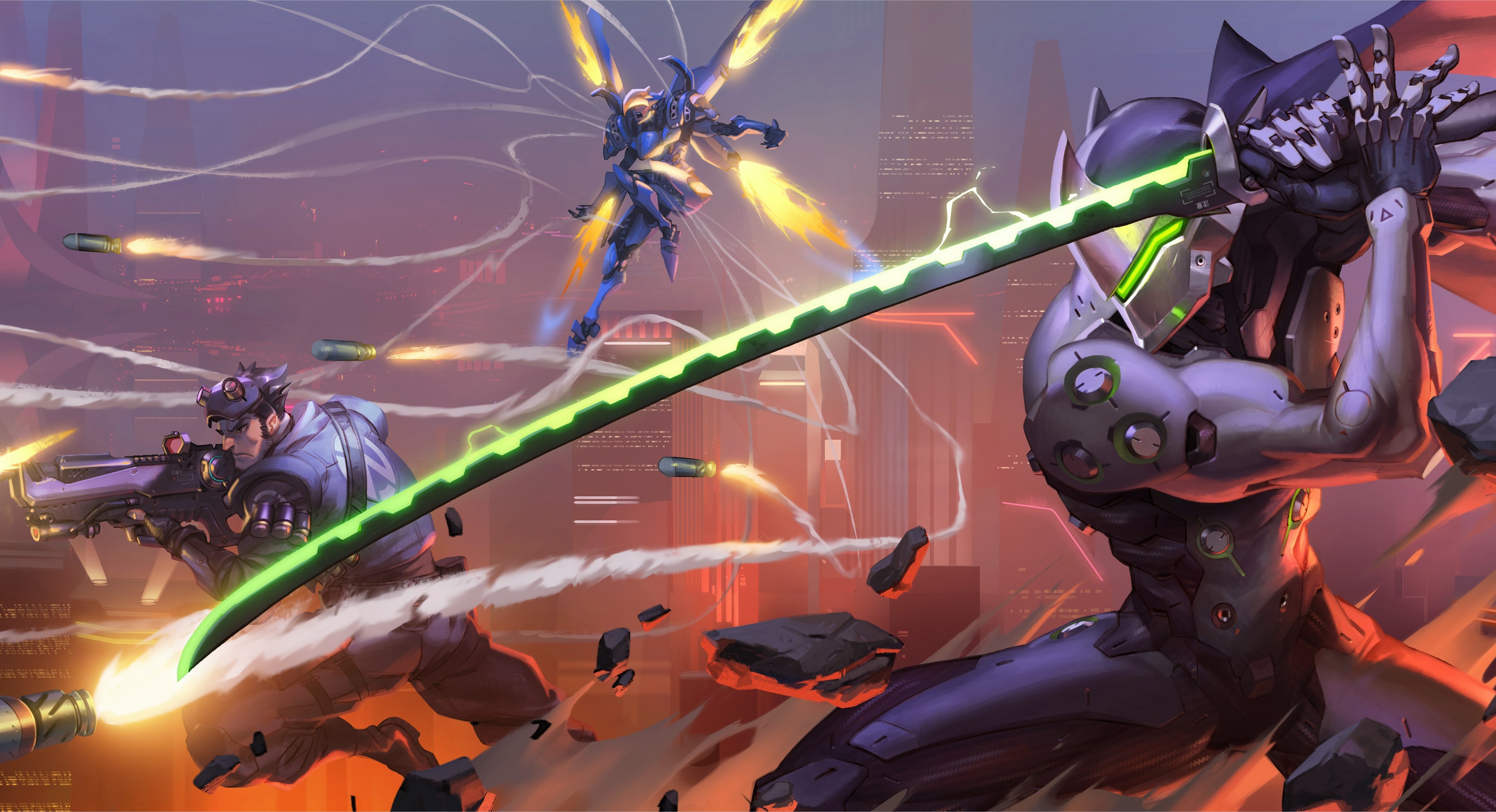
Pharah and Genji engage in action during Overwatch’s prime. They’re back for the recall.
You wouldn’t think all of this would be in the game, and you would be right. A lot of this extraneous information is regulated to short animations, comic books, website biographies, and the like. While it would’ve been an exciting experiment to have players unlock special story content as they level up or complete challenges, the tantalizing quotes characters utter and subtle, visual storytelling around maps provide great incentive to go out and study everything about this zany universe, which has some astonishingly emotional and epic tales to tell. Much of this has to do with the perfectly crafted characters, and boy, never have I seen a more ethnically and culturally diverse group of wildly disparate personalities in any game. People from all over the world are represented here, from a Brazilian DJ to a Chinese, female scientist to a Japanese cyborg to a pink-haired, female, Russian athlete-turned-soldier. Yes, those are all accurate descriptions.
Many have rightly pointed out that they’re so unique that Soldier 76, a seemingly generic “Call of Duty guy,” ironically feels like the odd one out here, but even he has more interesting backstory and character design than most multiplayer characters. They’re all truly likeable in their own ways, and you’re sure to not only connect with some that personally resonant with you, but also others that you’ll come to love if they happen to match your playstyle. That pink-haired, female Russian I mentioned? I never thought I would like her because she never appealed to me, but because I play as her the most due to her awesome abilities, that barrier was broken and she’s one of my favorite characters now. So, you’ll either come to adore new playstyles by using characters you love from the get-go or attach to characters you never thought you’d like because they feel great to master. It’s a clever, ingenious way to have players experiment and relate to all 21 individuals, but how do they play and complement each other? What’s the gameplay like? Well now, I’m glad you asked…or thought, perhaps.
Gameplay
Overwatch is a team-oriented game, and I sincerely stress that. Strategic coordination, balanced team composition, and minds focused on the objective rather than solo kills are essential components to victory. This isn’t your average multiplayer shooter where you can run around on your own and play however you please by racking up your personal killstreaks. You’ll be wiped out in a moment’s notice if you go in thinking like this because there are no modes that emphasize kills. With two teams of six players each, you’ll either be escorting a slow-moving vehicle to its destination in Escort, attacking two major points that the other team must defend in Assault, or battling for control of a single point in, well, Control. Respectively, they’re similar modes to Team Fortress 2‘s Payload, Attack/Defend, and King of the Hill. And while people have compared Overwatch to MOBAs like League of Legends, it’s only similar on the basis of having several classes of characters focused on particular roles; it’s much more akin to multiplayer shooters. However, while it mainly pulls this one inspiration from the MOBA genre, it does so to the extreme. The game goes overboard with a boatload of characters, and that’s one of the key things that makes it so successful.
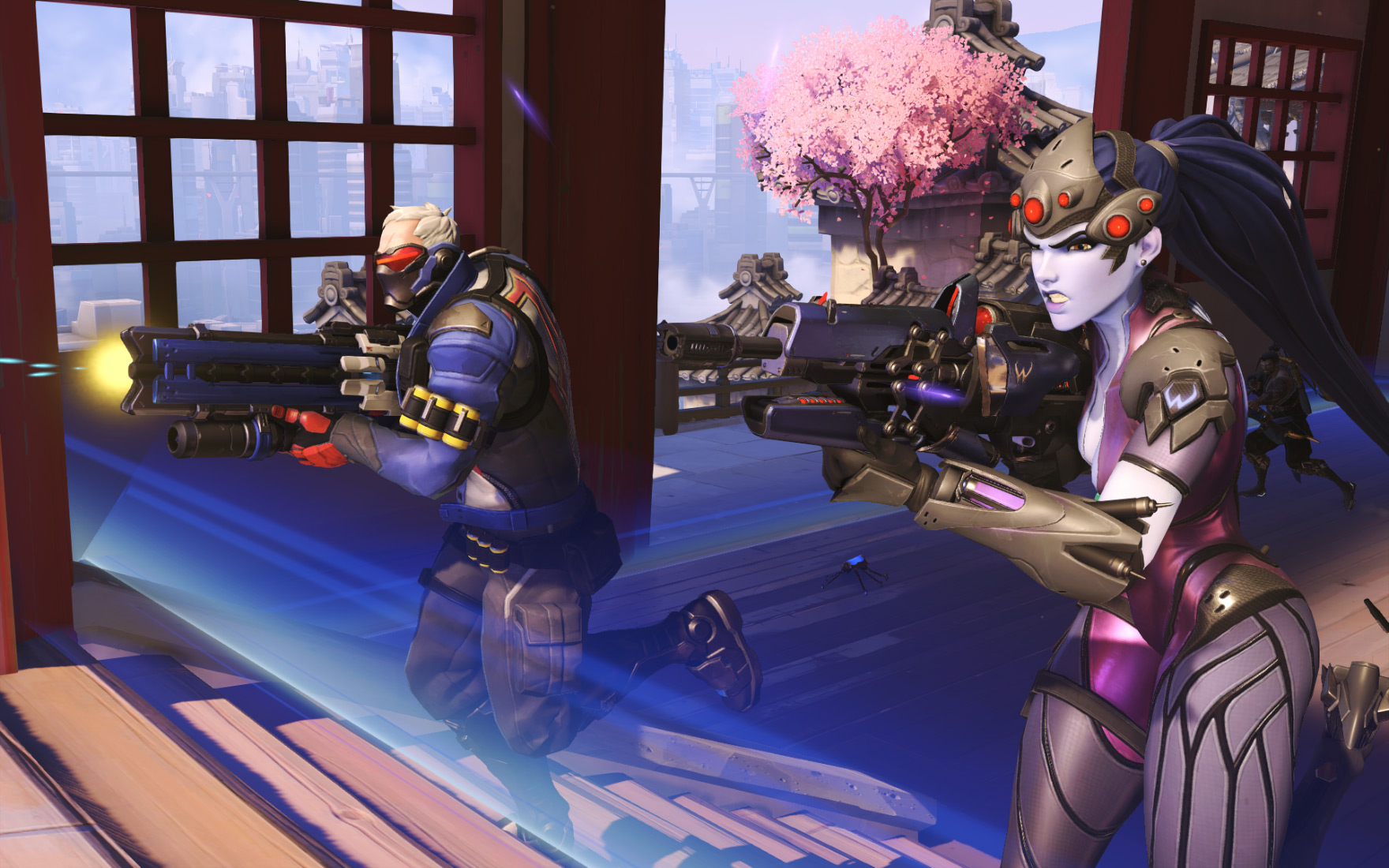
Soldier 76 and Widowmaker fend off the offensive team in Assault on the map of Hanamura. Hanzo is, um, helping?
Unlike characters in loosely-defined classes with Team Fortress 2, even more characters occupy specific roles with varying specialties in Overwatch. The Assault class, for example, has Soldier 76: your typical mid-range gunner with a sprinting ability, grenade launcher, and healing apparatus. Others like Genji are nothing like this. He can throw shurikens in two different ways, climb walls and double jump, deflect bullets for a limited time, and slice forward quickly with his sword. Both of these characters may be focused on damage, but the ways in which they deliver it are as dissimilar as how the other four characters in this class do so, too. This means that each character has nuanced purposes for any given situation. Is the enemy closely crowding a point you want to capture? Pharah is a phenomenal choice to deal with this, who can fly around and launch rocket barrages from above, and this isn’t including her special ability that sends out a rocket which blows enemies back. She’s still an Assault character, but can accomplish what Soldier 76 and Genji couldn’t do as effectively.
The same point extends to the Support class, which is an even more diverse group consisting of long-range eliminators like the bow-wielding Hanzo or sniper Widowmaker and the turret-placing Torbjörn or Bastion, who’s a robotic turret himself. Just as varying types of defense are needed to stay behind lines, the front lines need their Tanks as well. Reinhardt is the quintessential one with massive health, a shield that blocks up to 2000 damage points of firepower, a blunt hammer, and a horrifying charge that will pin anyone to a wall who happens to get in his way. Some Tanks are focused on more damage and individual defense like Zarya, while another named Winston largely serves as the fastest Tank that can distract and disorient the enemy for a time since he can leap large distances and send out waves of electricity. Lastly, the Support class is an underplayed yet key one that’s tasked with healing their team. Someone like Lucio is able to heal multiple teammates at a slower rate while providing speed boosts to his pals. He’s essential for Escort because of this, doubly so because he’s hard to hit and can keep enemies from rushing with his Soundwave ability, which launches anyone back who dares to get close. But if you want to focus on faster individual healing with a character that can also boost damage, Mercy can be excellent for holding the front line from the rear.
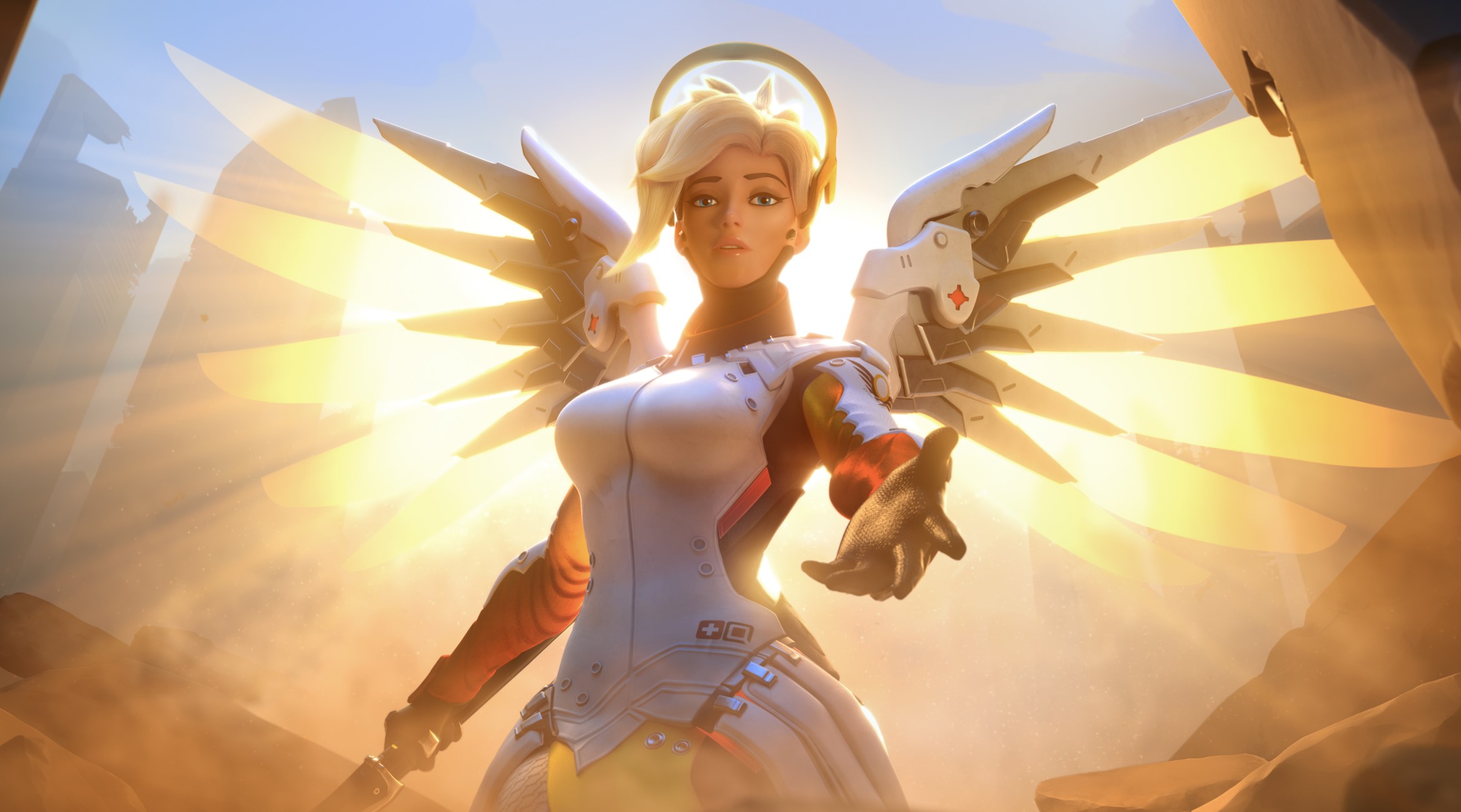
Mercy’s Ultimate, when timed right, can bring back your entire team from the brink of defeat. Take care of your Mercy and all Support players, guys.
There are far more abilities and other characters, but one thing that’s important to mention is Ultimates. These devastating moves give you a brief moment where you can change the tide of a battle, either by reviving your team as Mercy, activating D.Va’s self-destruct sequence with her mech, or freezing a group of enemies as Mei and taking them out where they stand. They aren’t solely meant to kill enemies across the board, but might only be useful to incapacitate or distract foes for a time or heal teammates depending on which character’s Ult we’re talking about. Even then that’s still an exceptionally broad generalization, glossing over how Ults are all different by accomplishing similar tasks with varying pros and cons. Because of this, combining Ults with team synergy is when they’re most effective, and that really speaks for what makes Overwatch special to play. Even though this is a shooter, it really isn’t your typical kind of shooter because of how unique every character is and functions, with many that don’t even, well, shoot! This means that no character is the same and you, therefore, will feel motivated to learn how to use them all in the pursuit of having the jolliest cooperation based on your teams’ needs. That’s the ever-shifting fun and spirit of Overwatch.
Figuring out which players should stick together, who we need on the battlefield at any given moment, and where everyone needs to be results in match after match where you aren’t focused on playing as your “main,” but who will bring your team to the finish line. It confused me from the get-go how some characters I wanted to master had so little depth or complexity to their movesets, such as Bastion and Reaper. However, after playing for several hours, I came to see that it didn’t matter how easy some characters were to play as, because the depth and complexity I longed for with individual characters was misplaced. That satisfaction came in the metagame of calculating and adapting to each match by switching to different characters on the fly, and because of this, I’ve only played as each character for two hours on average after 40 hours of playtime. This ensures that playing as anyone rarely gets old, especially since enemy team compositions will always result in unexpected, ever-changing types of resistance to combat. You may be playing the same three modes over and over for now, but matches never feel the same because of the diverse gameplay and matches. That’s what makes Overwatch so, so compelling.
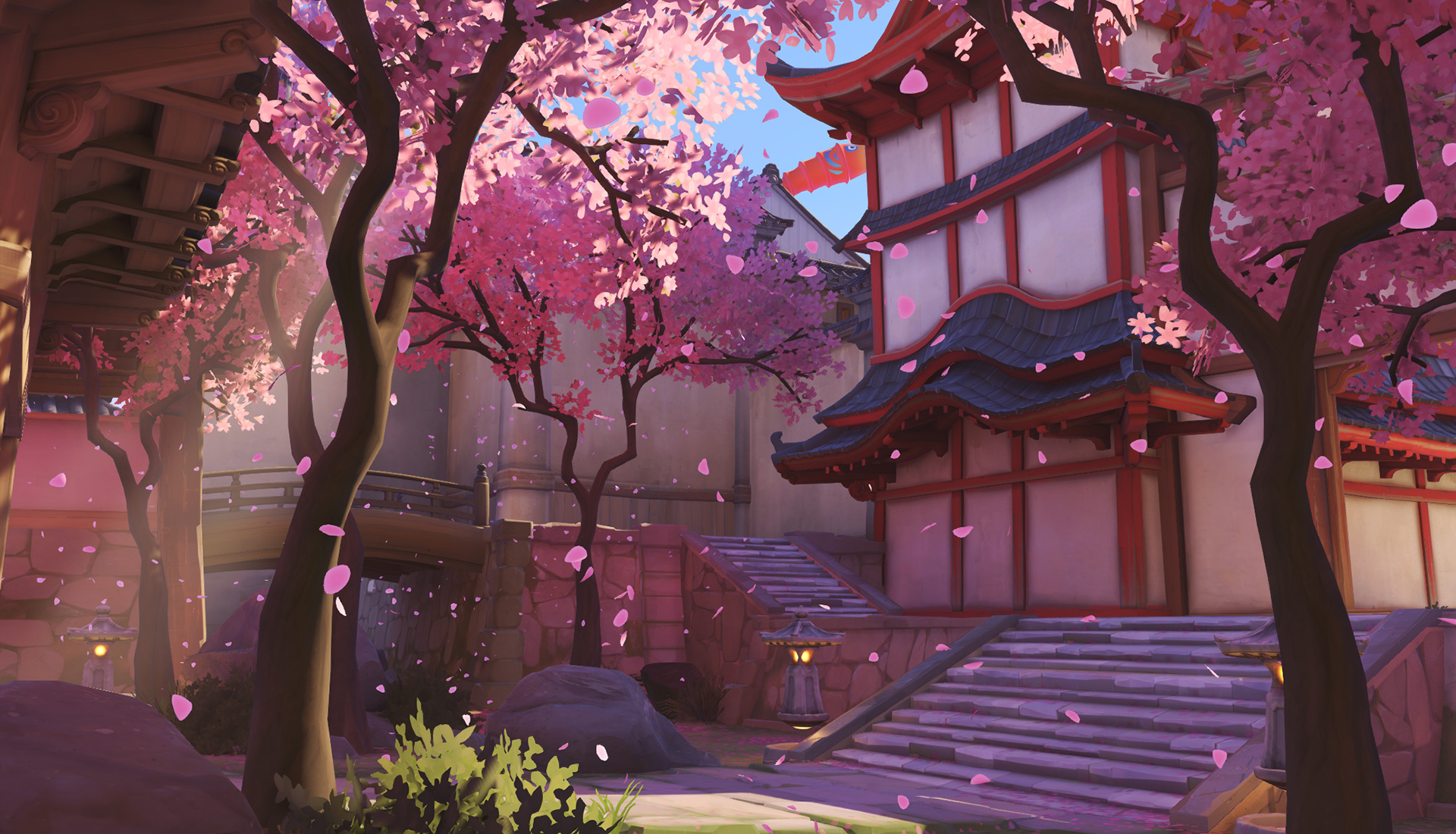
Petals fall from the Cherry Blossom trees of Hanamura. A peaceful scenery contrasted with the chaos of battle.
I’ve gotten this far without explicitly noting that while PC is the preferred platform, playing on the PS4 still feels like a dream for every character. This is a snappy shooter with endless playstyles that test your aiming and precision in numerous capacities, and with a host of maps set around the world with excellent layouts, verticality, choke points, and general flow, they are wonderfully designed for the modes they complement. That’s not to say that these maps are perfect though. Temple of Anubis, Hanamura, and Volskaya Industries have some spawn locations for the Defend team that feel closer to their points than they should be, which, on average, results in them winning more matches due to the ease of waltzing back into the fray, whereas the Attacking team has three to four times the distance to walk. Most of the time this isn’t a problem, but a smart, defensive team will take advantage of these spawn locations and choke points to an infuriating degree that makes some matches seem impossible to win, no matter how well your team performs.
These complaints could be partially done away with in regard to some balancing issues. But as a whole, I’m shockingly impressed the game has been mostly fair with a scope of characters like these. Some heroes like McCree and Widowmaker have received satisfactory patches with decreased damage, and with Torbjörn receiving a debuff to his turrets (thank the Lord), Blizzard is on the right track to further balancing the game. However, I do believe that other characters need work as well. Reaper should have a minor health or damage reduction to put him on par with the rest of his class. Hanzo’s arrows should probably have a smaller hitbox, D.Va should deal slightly more damage with her Fusion Cannons, and Reinhardt’s Ult should have better range and a wider radius among other minor, personal quibbles. I could also mention the current state of the new Competitive Mode, but the amount of rage I’d express over its issues are best ignored since it will be receiving a do-over in the coming months with a new season, which I’m sure will be a lot more fun and fair for both sides.
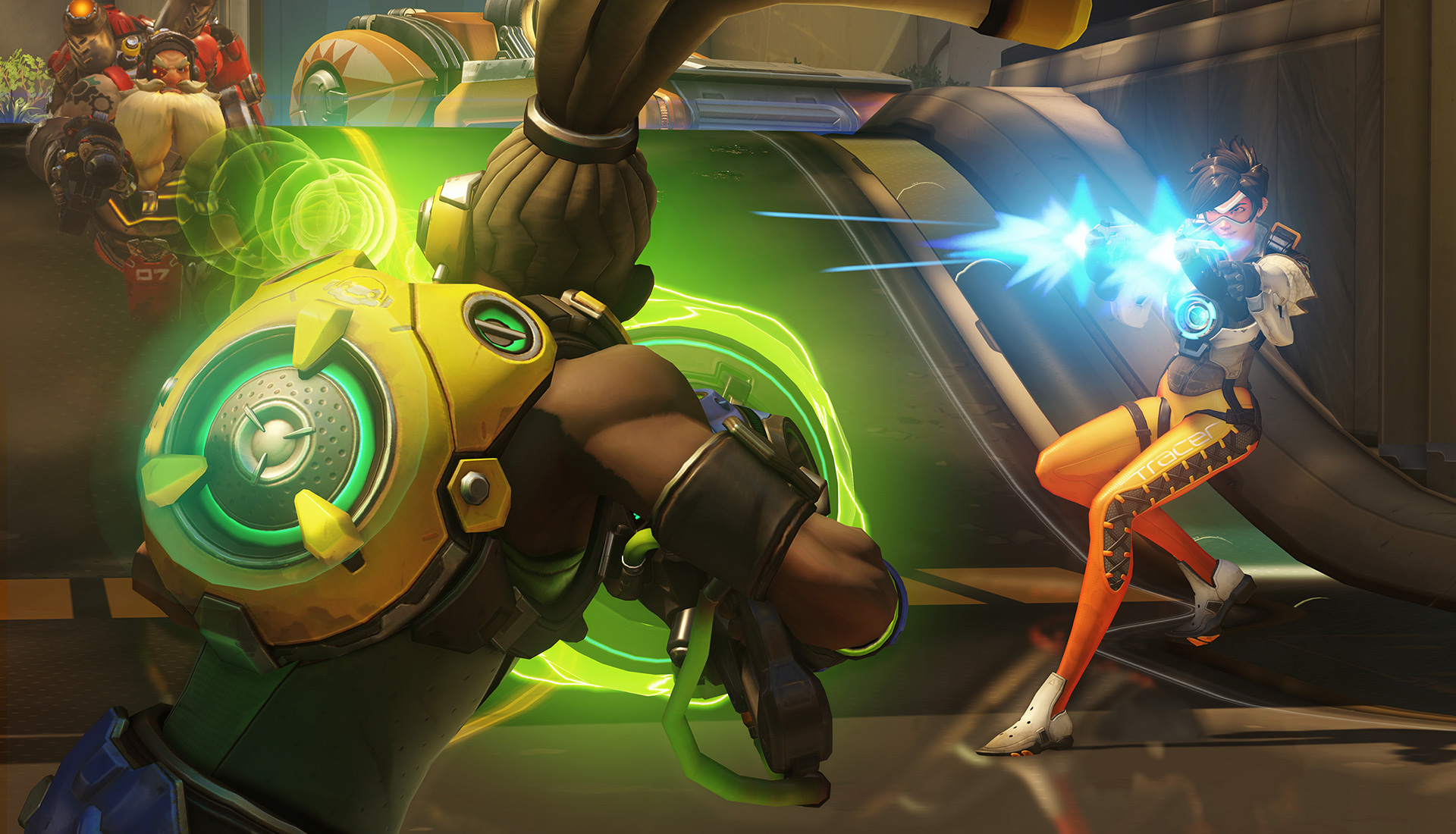
While the game is competitive and intense, most of the fun I’ve gotten from it comes from sheer satisfaction of beautiful cooperation. Winning is obviously nice, but I still walk away from matches feeling rewarded with teams that knew how to communicate and work together. There’s an inherent positivism in the community because of this, which brings so many kinds of players together that you wouldn’t usually see in games like this. The low learning curve is a plus, too.
While some have argued that Overwatch needs more content in its current state to justify its price tag, the fact that all new heroes, maps, and modes will be free is just icing on the cake for a game that’s already well-rounded and endlessly entertaining. You’ll scream in happiness and frustration in equal intervals, but even if you’re having a bad night of playing, you’ll be hard-pressed to stop in search of the thrill of being with teams that end up working together and crushing the opposition to perfection. The excitement of capturing points at the last moment…the rush of saving your entire team or single-handedly destroying the other with an Ult…the unpredictability of who you’ll play as or against next…the gameplay never misses a beat with the fun it provides with friends or even strangers. My watch with it won’t be ending anytime soon.
Visuals
This is one of the most aesthetically pleasing games I’ve come across in some time, and that’s especially true if we’re only counting shooters. It brims with a vibrant joy due to its Pixar-esque animation quality and style, aided by blasts of color and cartoony qualities that exceed the charm and memorability of Team Fortress 2’s graphics. There’s no question that – visually speaking – Overwatch will barely age with these timeless qualities. All of the characters’ designs match their personalities to a T, and the beautiful maps are nothing alike, which will have you traveling to snowy monasteries, the canyons of the Wild West, and the breathtaking Greek town of Ilios among other captivating lands that have lovely backdrops. As for the quality of the animation, there’s a bounciness, if you will, and energetic quality to how characters move around, aided by an oft neglected yet amazing technique involving “smear frames,” which humorously elongate and stretch character proportions to produce this visual flair. With minute facial expressions and body language that communicate more about their personalities than most animation in games has done, this game is an eye-popping treat that runs in 60 frames-per-second and bucks trends of grittiness and realism with amazing results.
Audio
Overwatch’s soundtrack is tinged with cultural instruments depending on where you are. Acoustic guitars, trumpets, and maracas enthusiastically greet you to the Mexican map of Dorado, whereas the African city of Numbani welcomes players with a warming African choir and xylophone. But what guides all of these cultural twists is a hybrid soundtrack packed with grand, orchestral themes and synthesized electronic beats. You’ll genuinely be inspired by the grandiose brass as it confidently blares out in the main menu or with victory along with the sweeping strings and percussion, which reminds me of John William’s heroic-sounding work for the Superman and Star Wars films, particularly (and respectively) with the main theme and the track that concludes Episode IV. The electronic aspect usually plays as ambient music before matches begin or while navigating the main menu. It usually consists of low-key effects that sound chopped up and, for lack of a better word, chill. It can range from being calm at lower tempos to heart-pounding as it ramps up in intensity to conclude the last minutes of matches. While I wish the game didn’t hide so much of the genius of this score by only playing small bits of much longer tracks, it’s still a glorious, aural complement to the good vibes this game inspires with its visuals.
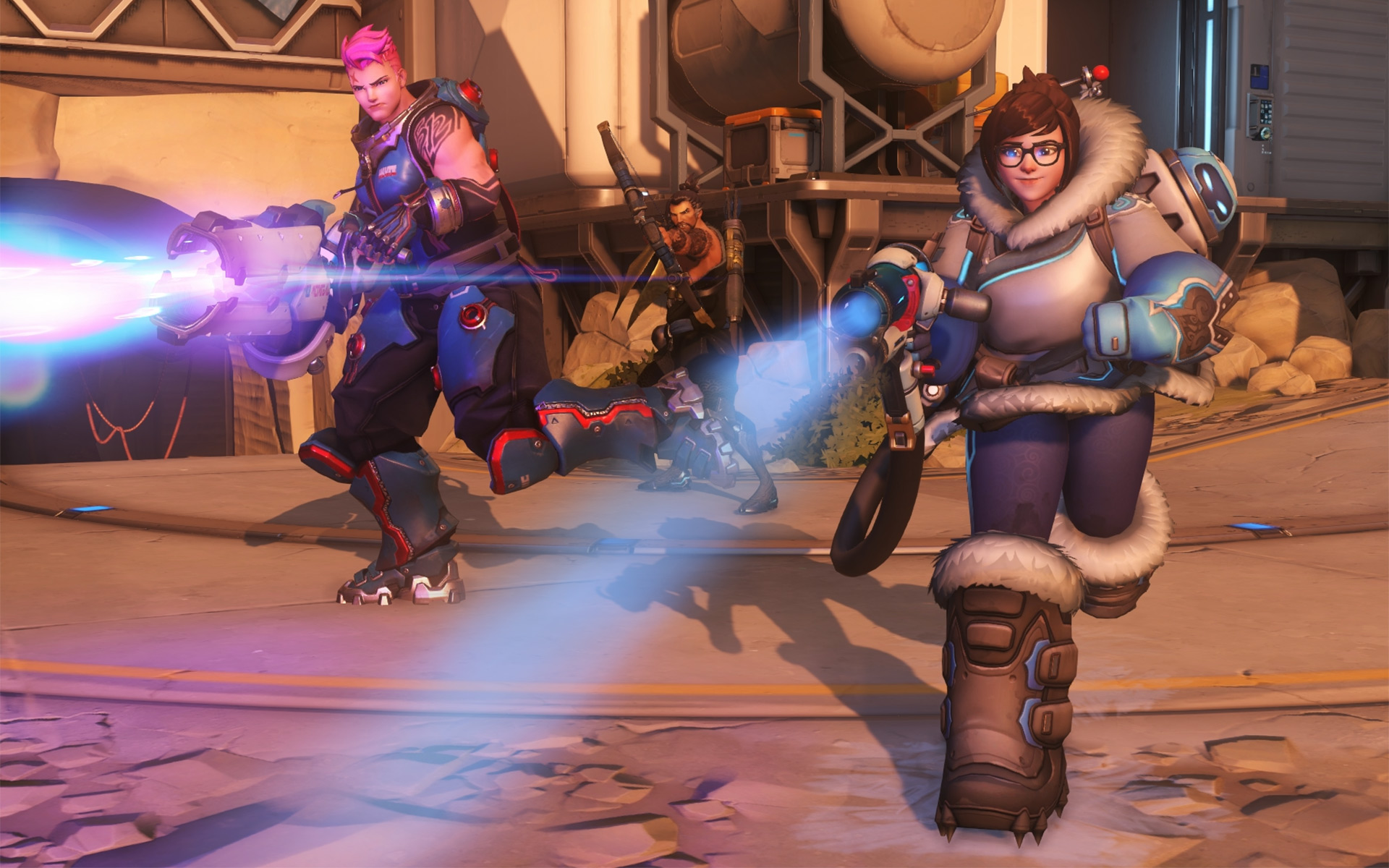
Mei’s Endothermic Blaster crackles and swooshes like a small blizzard as it shoots out ice to trap players. The eventual “clink” of the ice freezing them entirely is a nice touch and is so satisfying to listen to as you proceed to viciously impale them with icicle projectiles. Mei does it all with a smile. What an adorable monster.
The same can be said for its sound effects. I rarely delve into them with my critiques, but Overwatch really is worth taking the time to show off its sound effects. The fact that I can instantly recognize most heroes by their footsteps and clothing/armor ruffling around is an achievement in itself, but since each hero uses a kaleidoscope of equipment and weapons, everything they use has distinguished, creative sound design behind it, too. The creaking and groaning of Junkrat’s metal traps when they snare someone is oddly satisfying; the growing pitch and volume of Zarya’s Particle Cannon energy makes you feel like you’re becoming more invincible; and the clicking and clacking of McCree’s cowboy boots with the spurs make him sound like a true cowboy. Seriously, this is some darn sexy work on the sound team’s part. Not only because it sounds high quality, but also because so much of it is imaginatively original and downright iconic in some cases.
In regards to the voice acting, the actors and actresses recite lovely one-liners that will make you smile or roll your eyes in amusement, which complete the characters’ cartoony appearances with exaggerated, stereotypical voices. Reaper, former Overwatch member and member of the Talon terrorist group, is essentially a wanna-be Grim Reaper, and he fits the bill with a guttural, deep voice that could sharpen any blade with the amount of “edge” he exudes. He role-plays as his idol with typical phrases such as, “back from the grave,” or, “death walks among you” as seriously as possible, which comes across as cringeworthy yet enjoyable all at the same time. Mei has an adorable, quiet voice who will alternate between English and her native Chinese language; Zenyatta has a methodical, calming quality to his digitized, zen-like speech, and Tracer – as most people know – has an awful yet infectiously charming British accent, which she accompanies with plenty of common phrases and vocabulary to let you know she’s, indeed, British. Some of the voices may come off as laughable at first, but they match their characters very well, and since many of them will recite lines in another language depending on where they’re from, this attribute of the audio is just one more point that sells and accentuates the natural, compelling diversity of Overwatch’s cast.
Value
As I said while discussing gameplay, there are currently three modes available to play under the “Quick Play”category, which randomly places you in any kind of match. Thankfully, you won’t find yourself stumbling into half-finished games that often or be waiting that long since the category lives up to its name by quickly getting you into fresh matches without a hitch. There’s also a Play vs. AI mode, but once you adjust to the game’s characters after a couple hours there’s no reason to touch this. However, Weekly Brawl is a fun, little side mode that forces players to play as specific characters with altered stats. One week, teams might be able to play as only Soldier 76 with decreased health and stat recharging for Call of Duty-like mayhem. Another week you might find that the Support class is the only one available, and another might make things exciting by randomly switching your hero upon every death. It’s a quirky mode that provides some laughs by switching things around for a change, but we hope to see several more modes in the future. Perhaps Capture the Flag? Maps with moving points to capture? Only time will tell.
Competitive Mode, again, is not worth commenting on at the moment in its…less-than-desirable state of unfair time limits, luck-based favor for teams when matches are a tie, and so on. It will (hopefully) be far more enjoyable to earn Golden Weapons and rank up next season. But other than that, I should mention that by leveling up you’ll unlock Loot Box that grant you cosmetic items. Costumes to wear, stickers to spray on maps’ walls, voice lines, emotes, and the like are what you’ll find. When it comes to the good stuff like high-tier costumes and currency though, you can only pray and hope that fate shines well upon you when you open one. I honestly wish that cosmetics didn’t require so much chance, since the only way you can hope to randomly win something you want is to buy more Loot Boxes. You can’t even purchase the in-game currency, which I would’ve appreciated as an option since hoping on lady luck to provide you with this as well is a bit stingy on Blizzard’s part. And like I mentioned earlier on, I wish that there had been more to Overwatch’s progression system related to story content. I would’ve rejoiced if there had been unlockable cutscenes, biography excerpts, audio journals, and more that give glimpses into the Overwatch universe by just leveling up or even completing specific challenges. Further customization such as more weapon skins, minor cosmetics like hats or glasses, and so forth would’ve been nice as well, but at this point I’m wishfully thinking about possibilities for a game that already exceeded my expectations by offering hours of entertainment that has me crawling back for more.
Conclusion
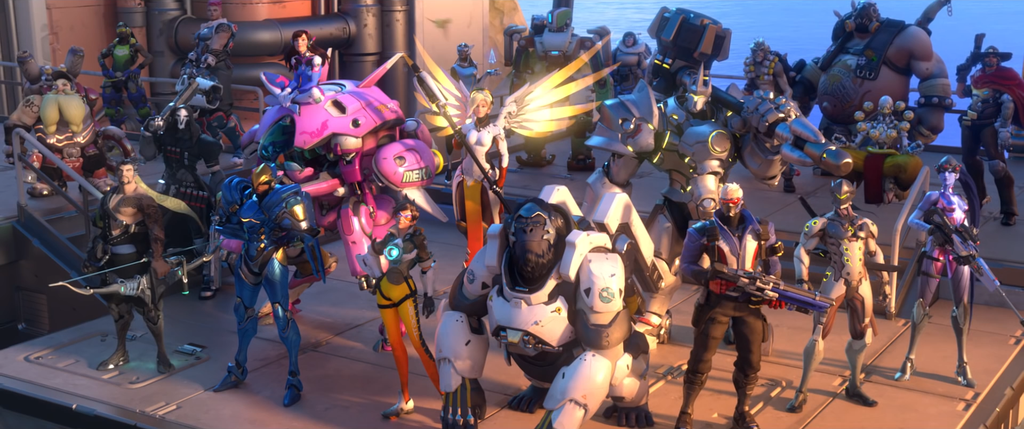
Like I said, it takes a lot for me to stay invested in a video game beyond its usual longevity. I’m usually in for the long haul with a campaign, but will cease to play any more of it once I’ve reached the standard ending. Multiplayer is a tougher case, which shouldn’t only amuse me for about a dozen hours until I grow bored of it. It should be something I always want to come back to with friends or even alone for months and months. Overwatch is the game I’ve been looking for that meets all these concerns of mine by always being a blast. It’s something I can’t get off my mind. Its 21 characters ooze personality and diversity not only with their drastically differing arsenals and abilities, but also with their appearances, backstories, and voices, making them characters that are wholly unique in a landscape of multiplayer shooters you’ll instantly gravitate toward and, eventually, fall in love with. Teamwork is an absolutely required virtue in this game, which is something that so many other multiplayer titles struggle to instill in players due to game design that allows and even encourages loner play. I know this because I’m inclined to do it. But with MOBA sensibilities in mind, you’ll have fun learning to play outwardly rather than inwardly with Overwatch, whether you’re used to that or not. You aren’t just a cog in the machine here. You act and feel like an essential piece of the puzzle to victory, which produces a sense of belonging to teams and thrill I haven’t had with any sort of multiplayer game in a long time, especially one that manages to be uncannily accessible. It contains oodles of replayability with a gorgeous, charming art style and animation, superb sound design, and modes that never grow stale. This is easily one of my top contenders for 2016’s game of the year. Let alone this generation of consoles.
Cheers, love.

